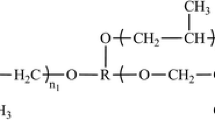Abstract
The effect of the composition of a polyisocyanate–polyester–foaming agent mixture on the density, the thermal conductivity, the mechanical properties, and the thermostimulated shrinkage of polyurethane foams is studied. Nonshrinking foams with a shape stability and a thermal conductivity of 0.0234–0.0310 W m–1 K–1 are prepared. A change in the polyisocyanate/polyester ratio makes it possible to control the thermostimulated foam shrinkage in the range from 0 to 78%.




Similar content being viewed by others
REFERENCES
Plant Engineer’s Reference Book, Ed. by D. Snow (Elsevier, Oxford, 2002).
S. Cai, B. Zhang, and L. Cremaschi, “Review of moisture behavior and thermal performance of polystyrene insulation in building applications,” Build. Environ. 123, 50–56 (2017).
M. Szycher, Szycher’s Handbook of Polyurethanes (CRC Press, Boca Raton, 2012).
J.-W. Wu, W.-F. Sung, and H.-S. Chu, “Thermal conductivity of polyurethane foams,” Int. J. Heat Mass Transfer 42, 2211–2217 (1999).
N. Sarier and E. Onder, “Thermal characteristics of polyurethane foams incorporated with phase change materials,” Thermochim. Acta 454 (2), 90–98 (2007).
D. Klempner and V. Sendijarevic, Polymeric Foams and Foam Technology, 2nd ed. (Carl Hanser Verlag, Munich, 2004).
K. M. Lewis, I. Kijak, and K. B. Reuter, “An image analysis method for cell-size and cell-size distribution measurement in rigid foams,” J. Cell. Plastics 32, 235–259 (1996).
H. Jin, W.-Y. Lu, S. Scheffel, T. D. Hinnerichs, and M. K. Neilsen, “Full-field characterization of mechanical behavior of polyurethane foams,” Int. J. Sol. Struct. 44, 6930–6944 (2007).
W.-Y. Jang, A. M. Kraynik, and S. Kyriakides, “On the microstructure of open-cell foams and its effect on the elastic properties,” Int. J. Sol. Struct. 45, 1845–1875 (2008).
D. K. Chattopadhyay and K. V. S. N. Raju, “Structural engineering of polyurethane coatings for high performance applications,” Progr. Polym. Sci. 32, 352–418 (2007).
P. Krol, “Synthesis methods, chemical structures and phase structures of linear polyurethanes,” Progr. Mater. Sci. 52, 915–1015 (2007).
Author information
Authors and Affiliations
Corresponding author
Additional information
Translated by E. Yablonskaya
Rights and permissions
About this article
Cite this article
Arzhakov, M.S., Yakovlev, P.P. & Lopatkin, A.I. Effect of the Composition of a Polyisocyanate–Polyester–Foaming Agent Mixture on the Properties of Polyurethane Foams. Russ. Metall. 2020, 441–444 (2020). https://doi.org/10.1134/S0036029520040035
Received:
Revised:
Accepted:
Published:
Issue Date:
DOI: https://doi.org/10.1134/S0036029520040035




